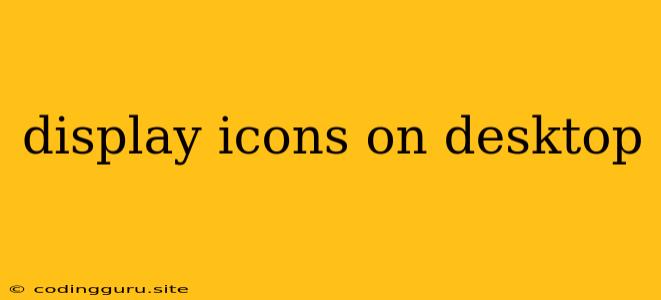How to Display Icons on Your Desktop: A Comprehensive Guide
Want to easily access your favorite applications, folders, and files with a simple click? Customizing your desktop with icons is a classic way to make your computer experience more personalized and efficient. But how do you actually go about displaying icons on your desktop? This guide will walk you through the process for Windows, macOS, and Linux, providing step-by-step instructions and helpful tips.
Windows
- Right-click on the desktop: This will open a context menu with various options.
- Select "Personalize": This will take you to the settings menu for your desktop appearance.
- Choose "Themes": Here, you'll find options to customize your desktop background, color scheme, and icons.
- Click "Desktop icon settings": This opens a window where you can select which icons you want displayed on your desktop.
- Check the boxes next to the icons you want to display: This includes common icons like This PC, Network, Recycle Bin, and User Files.
- Click "Apply" and "OK" to save your changes: Your selected icons will now appear on your desktop.
Tips for Windows Desktop Icons:
- Customize individual icons: Right-click on any existing icon on your desktop, select "Properties," and then go to the "Shortcut" tab. Here, you can change the icon associated with that particular file, folder, or application.
- Create shortcuts for specific files or folders: Simply drag and drop the file or folder onto your desktop, and a shortcut will be created.
- Organize icons using folders: Create folders on your desktop to group related icons and keep your desktop organized.
macOS
- Open "Finder": This is the main file manager on macOS.
- Navigate to "Applications": Here, you'll find most of your installed applications.
- Drag and drop any application icon onto your desktop: This will create a shortcut to that application on your desktop.
- For folders: You can also create shortcuts for folders by dragging and dropping them onto your desktop from Finder.
Tips for macOS Desktop Icons:
- Use "Stacks": This feature allows you to automatically group similar files or folders into a single stack, making it easier to manage your desktop.
- Organize using "Smart Folders": These folders automatically update with specific files or folders based on your criteria, like "Documents," "Photos," or "Recent Items."
- Customize icon size and spacing: In System Preferences > Desktop & Screen Saver, you can adjust the size and spacing of icons on your desktop.
Linux
- Right-click on the desktop: This will open a context menu.
- Select "Create Launcher": This option allows you to create a shortcut to an application or file.
- Choose the desired application or file: You can browse your system to locate the desired application or file you want to create a shortcut for.
- Customize the shortcut: You can change the name, icon, and other settings for the shortcut.
- Click "Create": This will create a shortcut icon on your desktop.
Tips for Linux Desktop Icons:
- Use "GNOME Shell Extensions": This is a powerful way to add features and customize your desktop experience, including managing desktop icons.
- Use "KDE Plasma": This desktop environment offers a wide range of customization options, including themes, widgets, and icon management.
- Install icon themes: Linux distributions allow you to install various icon themes, giving you a range of styles to choose from.
Why Display Icons on Your Desktop?
There are several reasons why you might want to display icons on your desktop:
- Easy access: It allows you to quickly launch your favorite applications, open frequently used files, and navigate to specific folders.
- Personalization: It allows you to personalize your desktop with your own unique style and preferences.
- Organization: You can group related icons together, keeping your desktop clean and organized.
- Visual appeal: A well-organized desktop with customized icons can make your computer experience more enjoyable.
Conclusion
Displaying icons on your desktop is a simple yet effective way to customize your computer experience. By following the steps outlined in this guide, you can easily create a personalized desktop that suits your needs and preferences. Whether you're using Windows, macOS, or Linux, you have various options to choose from. So, take the time to personalize your desktop and enjoy a more efficient and aesthetically pleasing computer experience.
